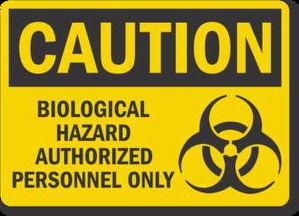Introduction
In the first blog in our safety series, Laboratory Safety: Biosafety Introduction, I shared an overview of what biosafety is, why it is important, and described primary and secondary barrier protection for laboratory professionals.
In part 2 of our safety series, I’ll discuss Biological Risk Assessment.
I will again be referencing Biosafety in Microbiological and Biomedical Laboratories, 6th Edition (BMBL6), which can be found here.
What is a biological risk assessment?
The short story is, biological risk assessment finds steps in your laboratory processes that put laboratory professionals at risk of exposure to a harmful biological agent such as a virus, bacteria, or fungus that could infect them.
The process involves
- Identifying the biological agents in the process and their hazards
- Systematically listing the steps in a laboratory process
- Observing the process in action
- Identifying which steps in the process introduce risk of biological agent exposure to laboratory professionals
- Evaluating if those risk points have a high or low likelihood of causing a laboratory acquired infection (LAI)
- Evaluating the probable consequences of the LAI
- Recommending mitigation actions to reduce or eliminate the exposure risk at the risk points
- Evaluating laboratory professionals’ ability to perform safety practices related to the mitigations
- Inspecting the integrity of safety equipment and replace as needed
- Communicating the risks and mitigation strategies to all stakeholders
- Circling back periodically to evaluate the process and change it, if needed, especially if the process has changed or new safety equipment is available
A guidance document to help you through performing a risk assessment is available from Clinical and Laboratory Standards Institute, which is document M29- Protection of Laboratory Workers From Occupationally Acquired Infections.
Inherent risk
In order to determine which level of mitigation is appropriate for the process, the initial risk assessment should include evaluating the inherent risk of working with the biological agent. Inherent risk is the risk of exposure if no precautions are taken to prevent infection by the biological agent.
For example, how likely is it that a laboratory professional would be severely ill with a group A Streptococcus infection if they did not wear a lab coat and gloves or work behind a safety shield? It would be a lower inherent risk because of the illness being less severe and antibiotic treatment being available. Something like Ebola, on the other hand, is almost certainly fatal if no safety practices were in place, therefore, it has a higher inherent risk.
The inherent risk takes into account how infective the agent is, the severity of the disease it causes, its mode of transmission (by air, respiratory droplets, or contact with surfaces), and if the absence of those safety practices will increase the likelihood of transmission. The higher the inherent risk, the higher the Biosafety Level that should be assigned.
A resource helpful for evaluating the hazard associated with biological agents, Pathogen Data Safety Sheets can be found here. They are similar to Safety Data Sheets for chemicals, but they list the hazards and handling for biological agents instead.
Identify Risk Points in the Process
Once you’ve determined the inherent risk of the biological agent, you need to identify risk points for exposure to that agent in the laboratory process. This is done using a job hazard analysis (JHA).
The JHA lists all the steps in the laboratory process and makes note if exposure to the biological agent is likely while performing that step. If exposure is likely, recommendations for safety practices are provided.
The best thing to do is completely eliminate the risk, which can be accomplished by changing how that step in the process is done. If the risk cannot be eliminated, then you change things in the environment to decrease the risk, such as using a biological safety cabinet to manipulate the specimens containing the biological agent. If those environmental changes do not lower the risk to an acceptable level, then laboratory professionals must wear appropriate personal protective equipment (PPE) while performing that step in the process. And of course, always wash your hands when you are done with the process and have removed your PPE.
OSHA has a job hazard analysis form to assist with the process, which can be found here. I’ll walk you through how to perform a job hazard analysis in part 3 of our safety series.
The end result is a determination of the biological agent’s biosafety risk level, which is then used to determine the appropriate biosafety level laboratory where the agent should be handled.
Assign Biological Safety Level to the Process
I’ll discuss the various levels of biological safety in part 4 of our safety series.
Risk mitigation
As mentioned above, once the exposure risk points are identified, you need to identify and select safety practices that would eliminate or reduce the risk of exposure at each risk point.
Options could include:
- Not handling the biological agent in that laboratory, which would eliminate the risk. Send it to another laboratory for analysis.
- Install environmental mitigations such as biological safety cabinets, better air handling in the laboratory space, negative air pressure in the room, remodeling the laboratory space to limit how far the specimen or biological agent must be transported to accomplish each step in the process.
- Use barrier protection such as splash shields
- Provide PPE such as lab coat, gloves, full face shield, N95 respirator, or powered air purifying respirator (PAPR)
- Implement disinfection steps
- Implement hand hygiene
Some of these items are best safety practices. What you choose will depend on the biological agent’s inherent risk, the setup of your lab space, and your financial resources.
Once the mitigations are selected, create training documents and work with lab leadership to train everyone performing the laboratory process. After the training is complete, create competency assessment documents and perform periodic assessments. Recommend corrective actions if any of the mitigations or steps in the process are being done incorrectly. Retrain anyone that might need it based on the competency assessment.
Engage safety stakeholders
It is critical to include laboratory leaders, organizational leaders, and subject matter experts in the risk assessment process. These are the people who can provide support financially and from a regulatory standpoint to allow you to implement mitigations once the risk assessment is complete.
Let them know when the risk assessment is happening. If they are in charge of the area, invite them to observe the risk assessment as it is being done in the laboratory space. Provide them copies of the final risk assessment along with the recommended mitigations and supporting regulatory standards that justify making the changes. And thank them for their support as we all work as a team to keep our laboratory professionals safe while performing their jobs.
Evaluate the implemented mitigations
Once the mitigations have been in place for a while, weeks or months, circle back to observe the laboratory process again. This can show if new risk points were inadvertently introduced, or if the mitigations are performing as expected and the process is as safe as we can get it for this particular circumstance.
Share this evaluation with the stakeholders. They like to see that their investment is worthwhile.
Promote a positive safety culture
The challenge in any laboratory is to develop sound safety practices and good habits among the laboratory professionals. Best practice is to train them initially and perform competency checks periodically to ensure the training is being followed.
Encourage lab leaders to speak about the positive safety changes when they huddle with their teams. Lab leaders should remind their teams that the safety team has lab leadership’s full support and the safety processes are in place ultimately for everyone’s safety, but especially for the laboratory professionals performing the hazardous work.
Invite members of each laboratory area to be part of a lab-wide safety committee, where they can bring safety concerns, or offer kudos to anyone who has adopted best safe practices. Involvement nurtures buy-in and buy-in nurtures adoption of the changes.
Conclusion: Don’t normalize the risk!
It’s important to understand that exposure to biological agents can have adverse consequences for those laboratory professionals working with the agents as part of their job.
Too often, we become accustomed to working in risky situations that have become second nature to us. We tend to normalize the risky situation and our minds begin thinking the risk isn’t as high as it really is.
When I think of normalized risk, I recall a story told to me by a NASA representative when I went on a safety tour of the NASA facility in Cleveland, Ohio. He talked about one of the space walks and a space suit that was nicknamed “the spitter” by the crew. The suit had a small issue that caused water vapor to spit into the helmet. It was never very much, so the crew didn’t think anything of it, so did not report it to anyone. Well, on this particular spacewalk, one of the crew experienced a more serious situation with “the spitter”. This time, there was enough water in the helmet that it blocked his nose and mouth. And since they were in space with zero gravity, the water did not move away from the front of his face. He was at risk of drowning in his helmet.
The good news: he was able to hold his breath long enough to make it back to the shuttle and get out of the helmet.
Lesson learned: no matter how small the malfunction, address it. At some point it could become a life-threatening issue.
We must protect ourselves and constantly remind ourselves that we are dealing with potentially deadly biological agents in our laboratories. We must remain diligent in adhering to our safety practices to keep ourselves and our coworkers safe from infection.
Follow best practices for safe handling of biological agents – it could save your life.

